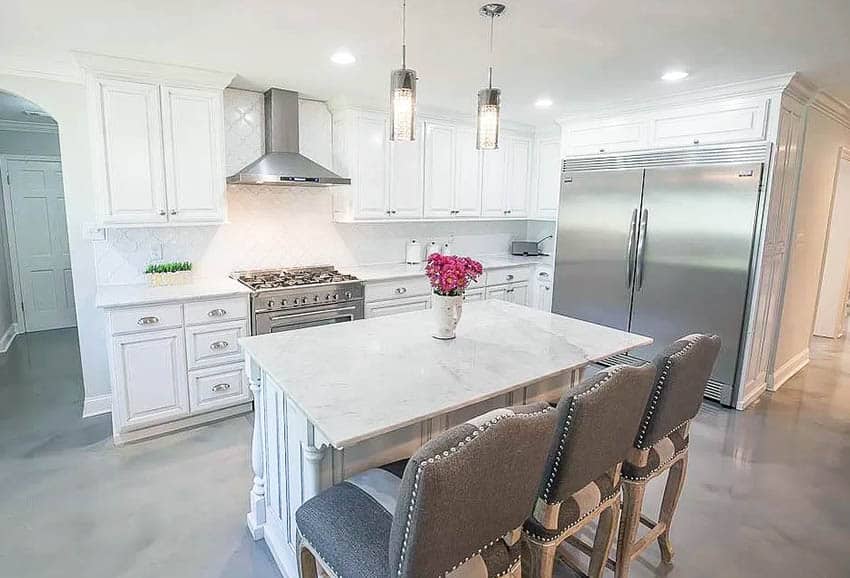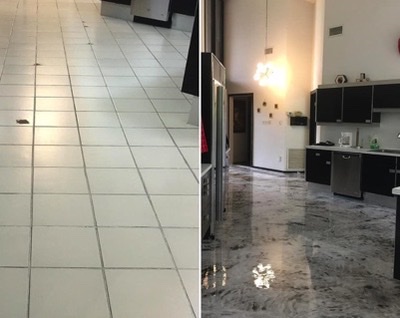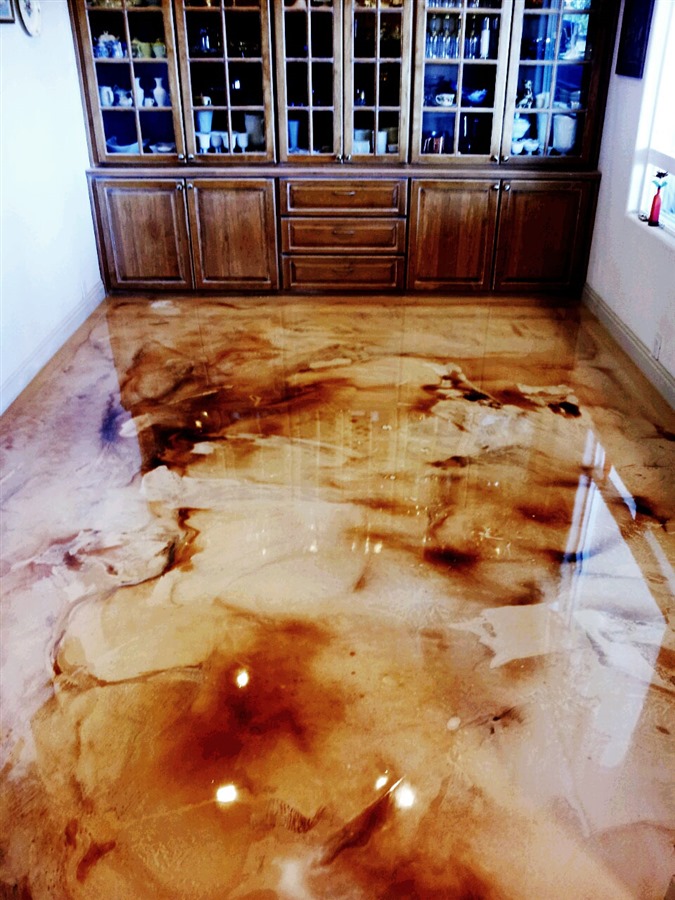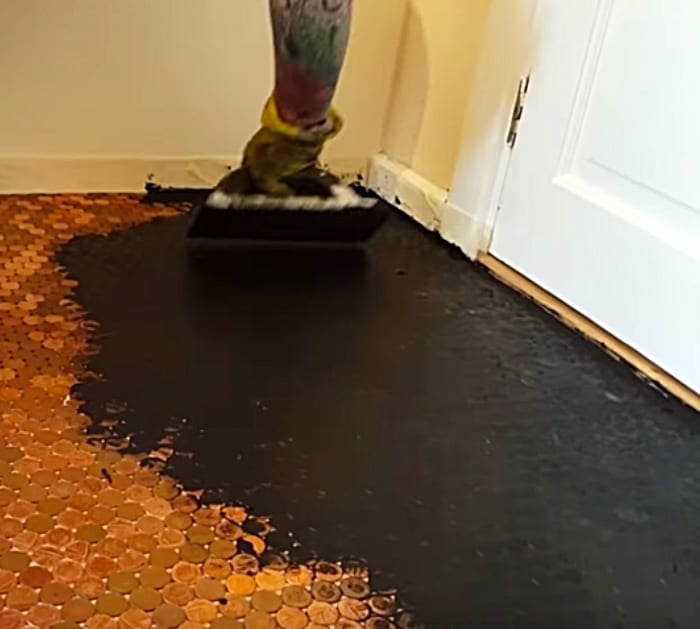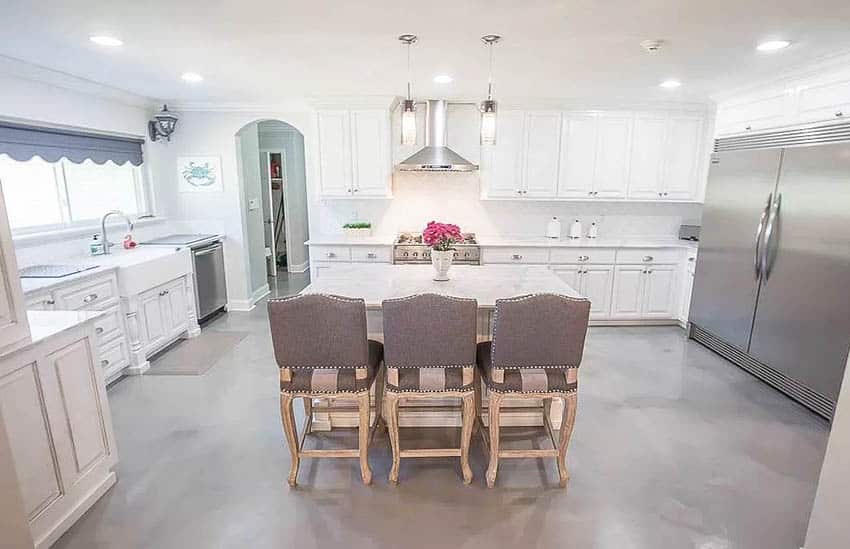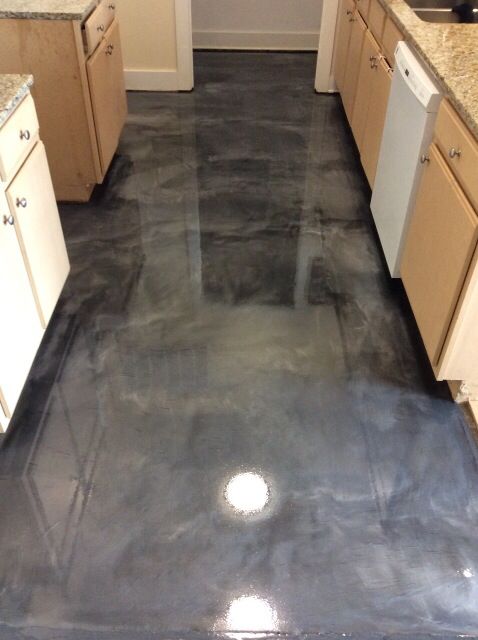Why Choose Epoxy for Your Kitchen Floor
Epoxy flooring has become a top choice for many homeowners, especially in kitchens. Not only does it bring a sleek, modern look, but it also offers durability, easy maintenance, and various styles that suit any decor. If you’re contemplating a flooring upgrade, here are the key benefits that make epoxy an excellent choice for your kitchen.
- Exceptional Durability
Epoxy floors are built to last, which is a significant advantage in a busy kitchen. Once the epoxy cures, it forms a hard, resilient surface that withstands heavy foot traffic, spills, and the occasional dropped pot or pan. Unlike tile, wood, or laminate, epoxy doesn’t easily scratch, chip, or crack, making it a smart investment if durability is your top priority. - A Seamless, High-Gloss Finish
One of the main aesthetic benefits of epoxy flooring is its seamless, glossy finish, which instantly modernizes any space. The high-gloss surface not only looks sleek but also reflects light beautifully, giving your kitchen a more open, spacious feel. If you love a polished look, epoxy delivers a unique, reflective quality that adds visual appeal to the room. - Stain and Spill Resistance
In a space as spill-prone as the kitchen, epoxy’s non-porous surface is a major advantage. Unlike other flooring materials that can absorb stains, epoxy repels liquids, making cleanup simple. Water, oil, or even wine spills can be wiped away without leaving a trace, and the surface won’t absorb odors, which is ideal in a kitchen setting. - Endless Customization Options
Epoxy flooring is highly customizable, offering a wide range of colors, patterns, and finishes. From solid colors to intricate designs, you can tailor the floor to match your kitchen’s style perfectly. Whether you prefer a subtle marble effect or a bold metallic shimmer, epoxy can be tailored to achieve almost any look. - Easy to Clean and Low Maintenance
One of epoxy’s biggest appeals is its low-maintenance nature. Without grout lines or crevices, there’s nowhere for dirt or bacteria to hide, making it one of the easiest surfaces to clean. A quick sweep and occasional mopping are usually enough to keep an epoxy floor looking pristine, which is a huge plus for anyone with a busy schedule. - Affordable and DIY-Friendly
Finally, epoxy flooring is relatively affordable, especially when compared to other high-end kitchen flooring options. It’s also a project you can tackle on your own with the right guidance, which can save significantly on installation costs. For a durable, stylish, and budget-friendly floor, epoxy is hard to beat.
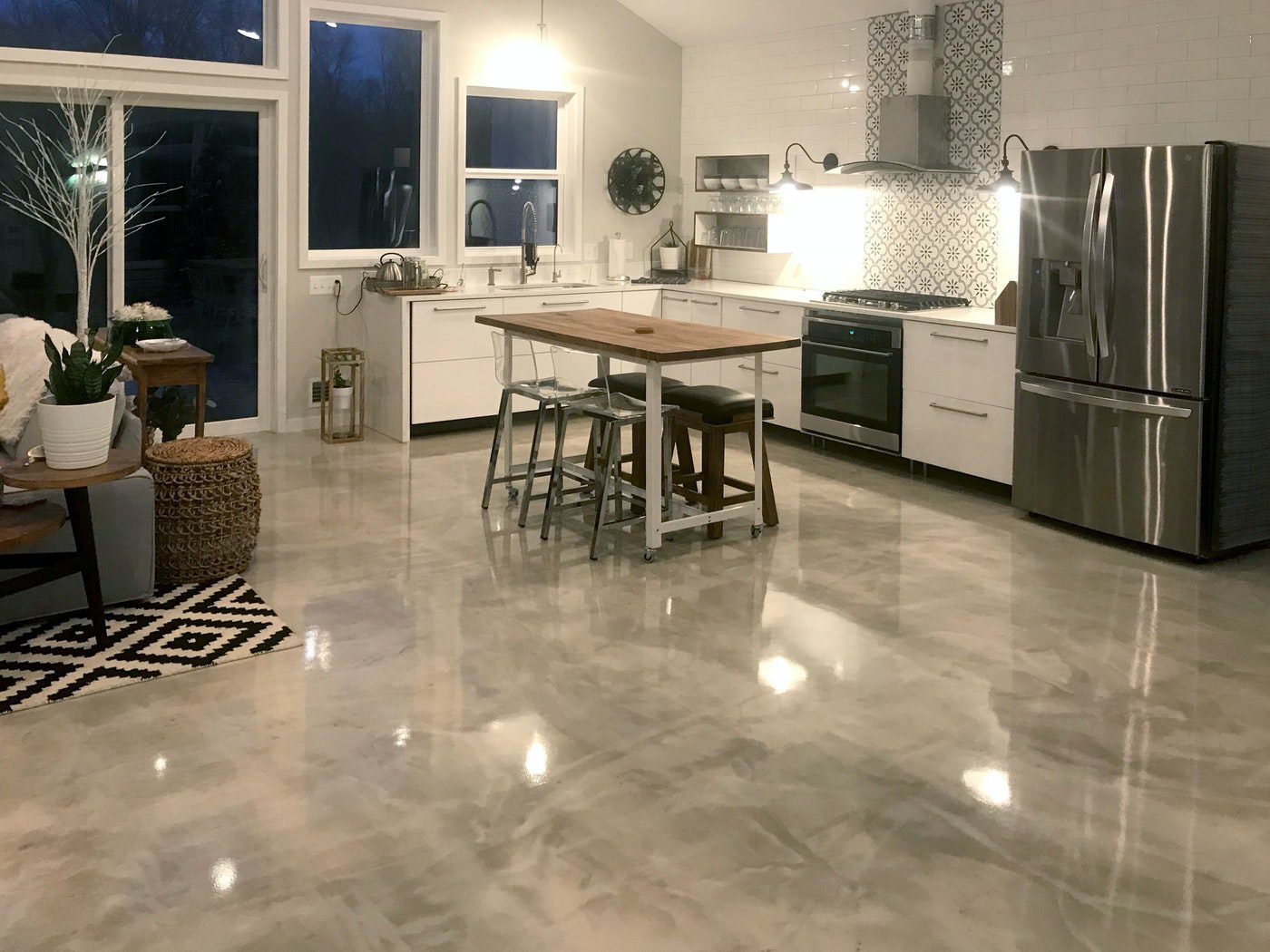
Prepping Your Kitchen Floor for Epoxy: Tools and Tips for Success
Preparing your kitchen floor for an epoxy coating is essential to ensure a beautiful and long-lasting finish. Without the right preparation, even the best epoxy can fail to adhere properly or end up with imperfections. Here’s how to get your floor ready for the epoxy application, step by step.
Gather Essential Tools and Supplies
Preparation begins with collecting all the necessary tools. For an epoxy project, you’ll need a floor grinder or sander, a shop vacuum, a degreaser, an etching solution (if needed), and a few other items like a roller, scraper, and mixing tools. Having everything on hand will make the process smoother and prevent last-minute runs to the store.
Start with a Thorough Cleaning
Epoxy requires a perfectly clean surface for proper adhesion. Begin by sweeping and vacuuming the floor to remove all dust and debris. Use a strong degreaser to tackle any stains, oils, or residues that might interfere with the epoxy bond. Taking the time to clean thoroughly at this stage will pay off in a smooth, flawless finish later.
Smooth Out the Surface
A level surface is crucial for an epoxy application. Use a floor grinder or sander to even out any bumps or imperfections. Epoxy highlights surface irregularities, so spending extra time on this step can make a significant difference. Aim for a smooth, consistent floor that’s free from cracks or uneven areas.
Patch Cracks and Fill Holes
Any cracks or holes in the floor should be patched before applying epoxy. Use a concrete patching compound for this, making sure to sand down the patched areas once they’re dry. Even small imperfections can impact the final look of the epoxy, so fill and level all gaps for a seamless result.
Check for Moisture
Moisture can prevent epoxy from adhering properly, so it’s essential to test for it before application. Tape a small plastic sheet to the floor for 24 hours to see if condensation forms underneath. If it does, you may need a vapor barrier or other moisture-mitigation measures to ensure the epoxy sticks well.
Prime the Floor for Better Adhesion
Priming the floor isn’t strictly necessary but can greatly improve adhesion and prevent air bubbles. Using a primer creates a better bond and enhances the longevity of the epoxy coating. Apply the primer as per the manufacturer’s instructions, allowing it to dry completely before moving to the epoxy stage.
Choosing the Perfect Epoxy for Your Kitchen Floor: Colors, Styles, and Finishes
With so many options for colors, styles, and finishes, choosing the right epoxy can feel overwhelming. But the variety is what makes epoxy such an exciting choice! Here’s a guide to help you pick the best type of epoxy for your kitchen floor.
Consider Different Types of Epoxy Finishes
Epoxy finishes range from solid colors to textured or metallic effects. A solid color offers a sleek, uniform look, while metallic finishes create an eye-catching, marbled effect. Flake epoxy, which includes tiny colored chips, adds a textured look that’s perfect for hiding minor wear or dirt in a busy kitchen.
Choose a Color Scheme That Complements Your Decor
Your epoxy floor color should enhance your kitchen’s aesthetic. Neutrals like gray or beige work well with most styles, but you could opt for something bolder if you’re after a unique look. Keep your kitchen’s cabinetry, countertops, and overall color scheme in mind as you make your selection.
Decide Between Glossy or Matte Finish
Epoxy can be applied with a glossy or matte finish. Glossy finishes reflect light and add a modern feel, but they can also show scratches more easily. A matte finish offers a more subdued look that’s forgiving with imperfections, which might be ideal if your kitchen sees a lot of foot traffic.
Explore Metallic Epoxy for a Unique Look
Metallic epoxy offers a unique, 3D effect that’s sure to catch the eye. This option is popular among those looking for a high-end, custom look. Although metallic finishes require more skill to apply, they can give your kitchen an extraordinary and luxurious appearance.
Consider Flake Epoxy for Added Texture
Flake epoxy contains small colored chips that create a speckled, textured look. Not only is this style visually interesting, but it also hides scratches and dirt. The flakes come in various colors, allowing you to customize the look to match your kitchen decor perfectly.
Ensure the Epoxy is Kitchen-Safe
Not all epoxy products are equally suited for residential kitchens. Be sure to choose a product that’s designed for floors and is safe for use in food-prep areas. Researching product reviews and checking safety ratings can help you find a high-quality epoxy that’s perfect for your kitchen.
Step-by-Step Guide to Applying Epoxy on Your Kitchen Floor
Applying epoxy to your kitchen floor might seem challenging, but with the right guidance, it’s a manageable DIY project. Following these steps carefully will help you achieve a professional, durable finish. Let’s dive into each stage of the epoxy application process.
Mix the Epoxy Components Carefully
Epoxy typically comes in two parts: a resin and a hardener. When mixed, these components begin a chemical reaction that makes the epoxy cure into a hard, glossy finish. Carefully follow the manufacturer’s mixing instructions, as the proportions must be precise. Use a clean container and a stirring tool, and mix for the recommended amount of time to ensure a smooth blend.
Start with the Edges
Using a brush, start applying the epoxy around the edges of your kitchen floor. This “cutting in” process ensures the epoxy reaches every corner and edge for a seamless look. Working on the edges first allows you to then focus on the larger, central areas without having to double back.
Apply the First Layer Evenly
Once the edges are done, you can begin applying epoxy to the rest of the floor with a roller. Move methodically from one side of the kitchen to the other, spreading the epoxy in even, sweeping motions. A thin, even layer is crucial here; applying too much at once can lead to air bubbles or pooling.
Use a Roller to Eliminate Air Bubbles
After laying down the first coat, use a spiked roller to roll over the wet epoxy. This tool is specifically designed to pop any trapped air bubbles, ensuring a smooth finish. Move slowly and steadily across the entire floor, making sure no areas are missed, as bubbles can mar the final look.
Apply Additional Layers for Durability
Many epoxy applications require more than one layer. After the first coat has dried completely (following the manufacturer’s recommended drying time), apply a second coat using the same method. Additional layers not only deepen the color and shine but also add to the floor’s durability, which is essential in a high-traffic kitchen.
Allow Proper Curing Time
Once all layers are applied, curing time is crucial. Avoid walking on or moving furniture onto the floor until it’s fully cured. This may take anywhere from 24 to 72 hours, depending on the product. The longer you let the floor cure, the more resilient it will be, so it’s worth the wait to ensure your hard work pays off.
Mastering the Art of Epoxy Application: Tips for a Smooth, Professional Finish
Achieving a flawless epoxy finish requires a bit of finesse. Even with the best materials, improper technique can lead to bubbles, streaks, or uneven coverage. Here are some pro tips to ensure a smooth, high-quality result.
Maintain the Right Room Temperature
Epoxy can be temperature-sensitive. For the best results, apply epoxy in a room that’s between 60°F and 80°F, as colder temperatures can slow curing and warmer temperatures can cause it to set too quickly. A consistent, moderate temperature allows the epoxy to level smoothly.
Work with a Partner for Efficiency
Epoxy starts to harden relatively quickly, so it helps to have a partner. While one person mixes the epoxy, the other can start applying it. This teamwork prevents the mixture from hardening before it’s applied, ensuring you’re able to work quickly without sacrificing quality.
Use Long, Even Strokes with the Roller
When applying epoxy, use long, even strokes with the roller to avoid streaks or uneven patches. Avoid pressing down too hard, as this can cause the roller to leave marks. Allow the roller to glide gently, covering the floor in smooth, overlapping strokes for an even coat.
Use a Spiked Roller for Bubble-Free Application
To prevent air bubbles from forming, run a spiked roller over the epoxy immediately after application. This specialty roller eliminates air pockets that can cause blemishes in the final finish. Moving slowly with the spiked roller ensures all bubbles are popped without disrupting the epoxy’s surface.
Avoid Overworking the Epoxy
One common mistake is to keep rolling over the epoxy too many times, which can lead to streaking. Apply the epoxy evenly, use the spiked roller for bubbles, and then let it settle. Overworking the epoxy can interfere with the curing process, leaving marks or dull patches.
Plan for Proper Ventilation
While epoxy is drying, ensure your kitchen is well-ventilated to help with curing and minimize odors. Open windows, use fans, or set up a temporary ventilation system to help circulate the air. This not only reduces strong smells but also helps the epoxy dry evenly across the surface.
Common Mistakes to Avoid When Installing an Epoxy Kitchen Floor
Installing an epoxy floor is relatively straightforward, but there are a few common mistakes that can make or break the project. Here’s what to watch out for and how to avoid pitfalls for a successful application.
Skipping the Floor Preparation Steps
One of the biggest mistakes is underestimating the importance of floor prep. Applying epoxy over a dirty or uneven surface can lead to poor adhesion, bubbles, and an uneven finish. Taking the time to clean, sand, and prime the floor will ensure a smoother application.
Ignoring the Manufacturer’s Mixing Instructions
Epoxy requires precise mixing, and it’s crucial to follow the product’s specific instructions. Mixing for too little or too long can alter the epoxy’s texture and curing time. Using a timer can help ensure you mix for the right duration, achieving the ideal consistency for application.
Applying Epoxy in the Wrong Temperature Range
Temperature matters when applying epoxy. Working in a room that’s too hot or too cold can affect the curing process, leading to cracking or a cloudy finish. Check the product label for recommended temperature ranges and avoid application during extreme weather conditions.
Applying Epoxy Too Thickly
Applying epoxy in thick layers might seem tempting, but it often leads to bubbles, cracks, and a less durable finish. It’s better to apply multiple thin layers, allowing each one to dry fully before adding the next. This approach creates a stronger, smoother, and longer-lasting finish.
Walking on the Epoxy Too Soon
Patience is key! Walking on the epoxy before it’s fully cured can damage the finish and create permanent marks. Even though epoxy may feel dry on the surface after a few hours, it often takes up to three days to fully harden, so it’s best to wait.
Forgetting to Seal the Edges
Epoxy can seep into cracks along the edges if not properly sealed. Applying painter’s tape around the baseboards and walls can help contain the epoxy and prevent it from damaging surrounding areas. Remove the tape carefully after the epoxy has set but before it fully hardens for clean, precise edges.
Caring for Your Epoxy Floor: Maintenance Tips to Keep It Looking New
Epoxy floors are durable and low-maintenance, but regular care can help keep them looking fresh and new. Here’s a guide to simple, effective maintenance practices that will preserve the shine and strength of your epoxy kitchen floor.
Sweep and Mop Regularly
Dust and dirt can dull the finish of an epoxy floor, so regular sweeping is recommended. Use a soft-bristle broom or a dust mop to remove dirt particles. For deeper cleaning, a simple mop with warm water and a mild cleaner will keep the surface looking shiny and new.
Avoid Abrasive Cleaners and Tools
Harsh chemicals or abrasive scrubbers can damage the epoxy’s finish over time. Stick to gentle, non-abrasive cleaners and avoid using steel wool or rough pads. A microfiber mop works well for routine cleaning and won’t scratch or dull the epoxy surface.
Address Spills Promptly
While epoxy is resistant to most stains, certain substances—like oil or acidic spills—should be cleaned up quickly. A damp cloth is usually enough to wipe away any spills without leaving a stain. This quick action prevents liquids from seeping into any small pores or imperfections on the surface.
Use Floor Mats to Protect High-Traffic Areas
In areas with heavy foot traffic or near the sink where water tends to splash, consider placing mats to protect the epoxy surface. Mats or rugs with non-slip backing can reduce wear and add a touch of style to the kitchen while helping to preserve the floor’s longevity.
Reapply a Topcoat Every Few Years
For long-term care, reapplying a topcoat every few years can help maintain the epoxy’s glossy finish. Over time, the top layer can wear down due to daily foot traffic. A fresh topcoat restores shine and gives added protection, making your floor look brand new.
Polish for Extra Shine
If you want to bring back the high-gloss finish, you can use a floor polisher or a specialized epoxy-safe polish. A gentle polish once a year will keep the epoxy looking like it was just installed. Be sure to follow manufacturer recommendations to avoid dulling or damaging the surface.
Huntersville Epoxy Flooring Huntersville, NC
Flooring Epoxy 1.5 Gallon Kit (Stone Coat Countertops)
Refinish Your Kitchen Flooring with High Gloss, Durable Epoxy
DIY Epoxy Penny Floor
Epoxy Floor (Ultimate Design Guide) – Designing Idea
Epoxy Flooring Ideas With Pros And Cons
Related Posts:





